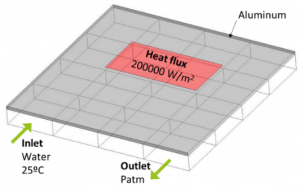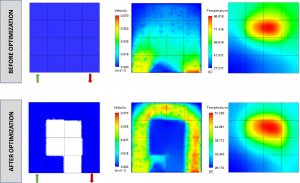As introduced in the first part of this series of articles entitled Development of a new topological optimization model to improve the efficiency of components for nuclear fusion, the high energy density of the IFMIF DONES accelerator beam causes some components to work in critical conditions, specially in terms of temperature and thermal stress. This fact presents a significant challenge, as it can jeopardize the proper operation and safety of the entire system. To address this challenge, Eurecat is working on the FusionCAT project in the development of a new method of topological optimization for the design of the cooling circuit of these types of components, considering fluid dynamics and heat transfer.
The method consists of dividing the design area where the cooling would be located into n porous media domains and optimizing which of them will allow the cooling fluid to pass through, creating a cooling channel, and which will not, becoming a solid part of the geometry.
At the moment, the project is in a research phase and work is being done on a geometrically simplified model (Figure 1), which is composed of 16 porous domains, where the porosity value (Φ) will be calculated. In addition, it also has an aluminum plate on top (gray part), where thermal power will be applied. For each domain, the model is capable of automatically determine:
- If the fluid can pass through (the domain is fluid): Φ=1
- If the fluid cannot pass through (the domain is solid): Φ=0
 Figure 1: Approach of the optimization method initial model
Figure 1: Approach of the optimization method initial model
Regarding flow modeling, a turbulent regime has been considered, solved by the RANS k-ε method. Thermal equilibrium between the porous medium, the solid and the fluid has also been assumed. Different optimization methods (for example based on genetic or adaptive algorithms) have been investigated, with the aim of determining the most efficient method that allows to reach a solution that is as optimal as possible in the shortest possible time.
In the case of study, the objective would be to minimize the aluminum plate temperature by modifying the design of the cooling channel, that is, investigating different combinations of porosity (making the domain fluid or solid) until finding the combination where a lower temperature on the plate is achieved. Therefore, the present case would have a single objective complemented with some restrictions to help in finding viable solutions.
In Figure 2 a comparison of the initial situation and the optimized solution obtained through the developed methodology can be seen. As shown, the optimization method has been able to automatically find the most suitable cooling channel design to achieve the lowest possible temperature on the aluminum plate. In the initial situation, the starting point was a maximum temperature of 86.0ºC, and the new design obtained through the topological optimization method has managed to reduce the temperature by 40%, with the new maximum being 51.3ºC for the optimized design.
 Figure 2 Comparison of the results before and after the optimization of the cooling circuit
Figure 2 Comparison of the results before and after the optimization of the cooling circuit

